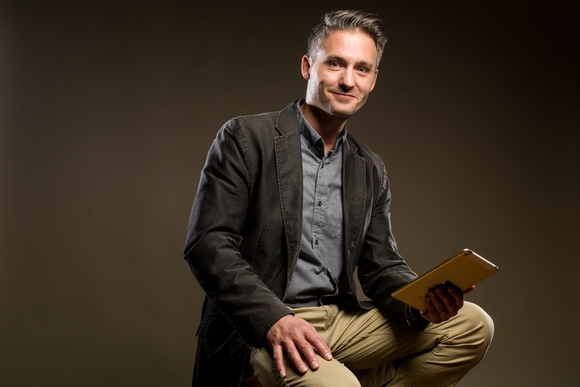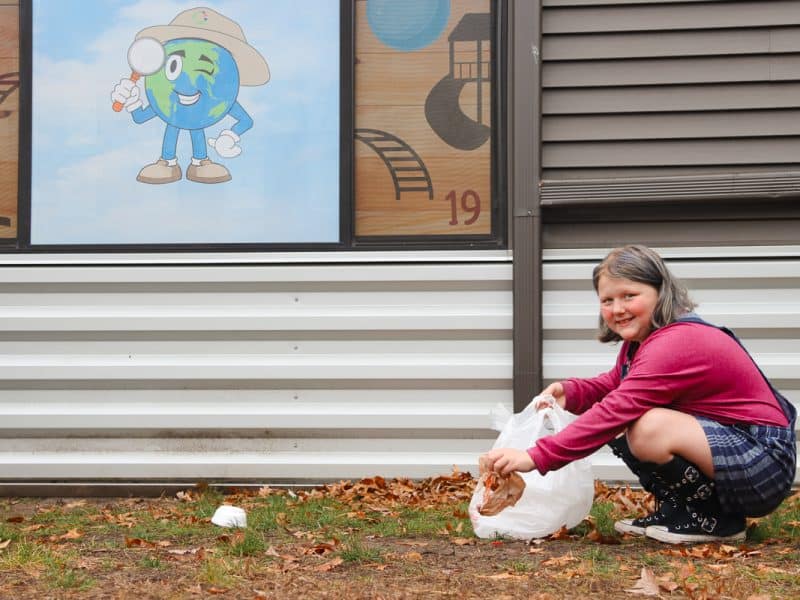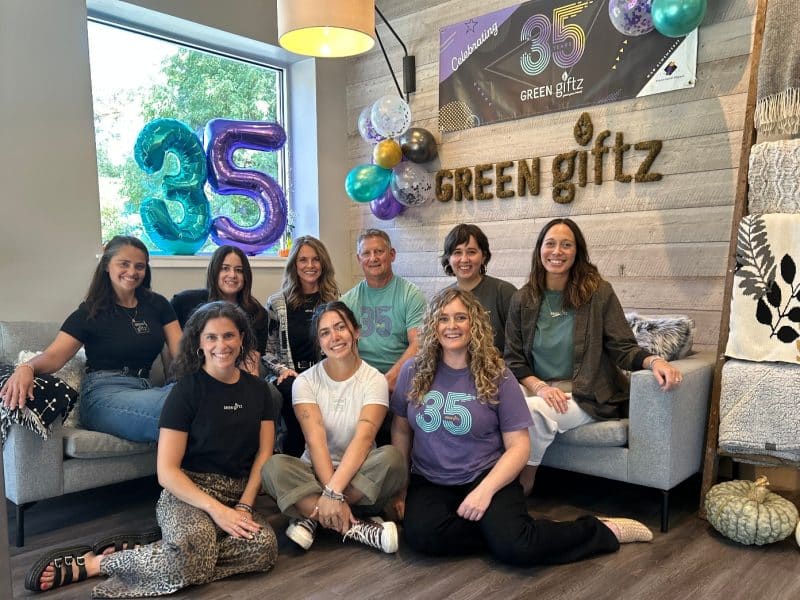Wizards of the digital age: West Michigan tech leaders change the world with the Internet of Things
The Internet of Things is pushing the boundaries of technology, and West Michigan leaders have keen insights on a frontier that is revolutionizing the way the world interacts.

In the last few decades we’ve essentially brought an entire planet within reach of a handheld device, we’ve taught machines to learn from each other, and we’ve given ourselves access to more information than our ancestors could ever dream of. From an outside perspective, technological advances like the internet may seem like magic. To those who study its potential, designing new ways for humanity to experience the world around us, it may as well be.
Among the most popular emerging technologies today, one area in particular is focused on connecting us, digitally, with more and more of the physical world around us. The Internet of Things (IoT) is an evolving platform that devices, machines, and some of the simplest physical objects use to sense, collect, analyze, and exchange data while being connected to the web. It extends the reach of our experience, and to local connector and practicing wizard of the digital age, Laurel Stanley, it’s the natural evolution of technology.
“Over the years, computers have grown smaller and smaller, most recently from desktops and laptops to tablets and other handheld computers; the smart devices we call ‘phones,’ says Stanley, User Experience Design Lead of Global Brand Design for Herman Miller, the iconic furniture manufacturer based in Zeeland, Michigan. “With the emergence of integrated RFID [radio-frequency identification] and sensor technology, both hardware and software has been transformed, allowing devices to collect information without direct human input. Thus we’ve seen devices become wearable, embeddable, and more pervasive with technology being integrated into automotive, fashion, home appliances, office settings and more.
“IoT is the invisible connection of all these devices that makes them smart. The system of devices that are part of the IoT are constantly interacting with each other, the internet, and of course the end-user, hopefully in service of creating an elevated human experience.”
Far from a vaporous buzzword, the IoT represents a faction of technology that’s been around for decades. Our earliest examples come from credit card machines communicating with each other via the internet. Since then, countless devices and IoT-enabled items have entered mainstream use. From ordering cat litter at the push of a button; weather, news, and music when you ask; or monitoring your home utilities from your smartphone, the IoT has not only pervaded our modern technology, it’s improving it.
As far as a definition goes, the IoT umbrella is incredibly vast, but the elements underneath share one commonality — the ability to communicate and report actionable data to each other over the internet. That covers modern washing machines, air quality monitors, surveillance cameras, and even entire cities.
Gartner, an analyst firm, reports there will be around 6.4 billion connected devices this year — things like smart cars, trains, heart monitors, and a whole lot more. That number, which represents a 30 percent jump over 2015, is expected to skyrocket to more than 20 billion by the year 2020, according to Gartner.
According to Siemens, the largest engineering company in Europe, this “fourth Industrial Revolution,” is our next jump into the future, following the innovations of steam, electricity and wired computers. Billions of devices are connected to the internet, and they’re talking to each other; they’re learning. We now live in a world where your car can access your online calendar, your phone’s alarm clock can trigger your coffee maker, cities are far better equipped to monitor traffic activity, police forces and a vast sea of other services, programs and departments. You can literally order a pizza from a light bulb if that’s how you so choose to live your life. It’s a world of convenience, yes. But it’s more one of being connected.
User experience
“It was back when the internet was referred to as ‘new media,’ and some even considered it to be a fad,” she says. “It was back before you could get a degree to become a user experience designer, an interaction designer, an information architect, an SEO analyst, or the multitude of other roles that have been built up around the internet.”

It’s safe to say the internet is no fad, but it’s also grown enough to be nearly indistinguishable from its early incarnations. When Stanley first entered the realm of digital media, she was designing and building online web applications for local businesses like Herman Miller, Steelcase, Wolverine World Wide, and Priority Health.
While her focus in college was on graphic design, Stanley’s dedication to building websites on the side led to even more interest in the fields of interactive design and usability. She studied at Michigan State University before transferring to Kendall College of Art and Design for her undergraduate degree. At Kendall, Stanley also earned a BFA in Visual Communications in 1999 and a master’s in design in 2015.
“In the early 2000s, I attended Jakob Nielsen’s week-long Usability Bootcamp and have been incorporating user research into my designs ever since,” she said. “Pursuing an understanding of human behavior was pivotal in allowing me to eventually call myself a user experience (UX) designer. My career has enabled me to blaze my own trails, often writing the job descriptions for the organizations who employed my talents.”
Almost 10 years ago now, Stanley started migrating her efforts from building tools for the corporate world to building experiences for startups, and she joined the founding team of Grand Rapids’ international art competition, Artprize.
“I designed the technology platform on which the event runs; connecting artists, venues and voters,” Stanley says. “Working with ArtPrize allowed me to build both virtual and physical systems. Beyond the technology, I had to consult with venues and support voter registration booths throughout city. Being part of that venture still is a great source of pride, especially since ArtPrize is celebrating the completion of its eighth season.”
User experience design forms out of the viewpoint of the user, Stanley says. It’s an amalgamation of business strategy, technology, and design, and often indistinguishable from a brand. The experience is a direct reflection of the hosting organization, and being able to design those experiences is a challenge Stanley rises to, connecting the dots and impacting others in a more meaningful way as technology evolves.
“I truly love the constant pursuit of understanding the human element of technology, which is foundational to UX,” she says. “I get to be part of shaping the conversation around what it means to be a UX professional. Even now we see user experience evolving into customer experience and instead of designing for specific devices, UX professionals are being called upon to design systems to support broader, more immersive experiences. With ArtPrize, I created experiences that touched hundreds of thousands of people. Today, working at Herman Miller, I touch millions worldwide.”
Scaling up, shrinking down
Turning a thoughtful product or convenient feature into an application that can affect large populations is no easy task, but it’s a crucial step of IoT design. And the world’s biggest technology companies have been showing, in billions of startup and research and development funds, just how important it will be to our future.
In the home, products like Nest’s smart thermostats, smoke, and carbon monoxide detectors have proven their worth to the tune of a $3.2 billion investment from Google, while voice controlled speakers and IoT hubs are overtaking smaller speaker systems in popularity. In an IoT connected household, Stanley envisions her scheduling and notetaking could be some day integrated into the devices, and even vehicles, she’ would be using. It could help her make every minute count.
“My day starts with an alarm that knows when to wake me up based on my daily calendar. It then automatically gives me the weather report so I know how best to dress the kids for school,” she predicts. “As I am making breakfast, my refrigerator notifies me that I am out of milk and automatically adds it to my grocery list. That grocery list is automatically connected with the grocery store I shop at and at 15 items, sends an order through to the store that is delivered to my door later that day. I drop my kids off to school and am notified that they are accounted as they enter the doors. On my way to work my device automatically looks at my typical route and determines if there are any traffic slow-downs. If detected, I get alerted to an alternative path so that I can make sure to arrive in time.
“If I am running late, my device sends out a notification to everyone in my first meeting to let them know I am running behind and my expected arrival time. And that is just for starters.”
Extending access to many elements of the home through apps and convenient commands is certainly part of the IoT, but it’s no longer the cutting edge.
“IoT is in its infancy, however, the potential is that it transforms how we live day-to-day and enhances how we inhabit our world,” Stanley says. “I think it will be interesting to watch and see how it impacts culture, our sense of community, and our ideas about place.”

Already in West Michigan, the IoT has come to enhance places of manufacturing and retail, as well as industrial applications. Kedron Rhodes, UX Manager for the Wyoming, Michigan-based Gordon Food Service, the largest privately held food service distributor in North America, says the business applications of the IoT are constantly expanding. From traceable RFID tags on specific products or beacons (devices that communicate with a shopper’s smartphone in the shop to, for example, send coupons or other announcements) in key sections of a store, customer service can be optimized by helping people find the items they need as soon as they need them. Ambient devices triggered by online shopping data or another beacon coming within range can make the entire process, from ordering to pick-up, much more efficient. It’s actually the constant adaptation and drive toward higher efficiency that makes a good IoT device, Rhodes says, possibly best demonstrated by our modern robotic workforce.
“IoT has also continued to grow in applications in the space where there is no human involvement, but a network is available to manage products through a process, relying on the efficiency of software and machinery,” he says. “For example, in manufacturing, putting an RFID tag on an object as it’s being manufactured allows each machine, or each device that’s working on that part, to have a unique awareness of it. That awareness can help a machine make a better decision about what to do with that part, it can help catalog the part, it can help determine what to do next. There’s no human involved in that but it’s definitely adding value to a machine and software.”
Rhodes has made plenty of connections of his own over the course of his career. Similar to Stanley, his work experience reads like a who’s who of West Michigan technology and design leaders, although he says one of the things that drew him to the user experience side of the work, as opposed to the computer sciences end, is an interest in the human condition. From that viewpoint, Rhodes says the IoT is in a unique position, as it has potential to either prove valuable through further leaps in efficiency and function, or by meeting other, deeper human needs.
Worldwide data
“One of the beautiful things about the Internet of Things is that most of the data that’s being transferred with these devices is in such small nuggets; it’s safe even on an old school 3G device,” Rhodes says. “You don’t need Google fiber to show up in your city for the IoT to work. You can get a $20 device that sends all sorts of relevant information through a 3G network.”
By connecting a few inexpensive sensors to a database through this nearly ubiquitous network, scientists and communities as a whole not only get a greater understanding of the physical world around them through weather and air quality reports, but they can also monitor soil makeup, mitigate crop disasters, and all but outsmart nature itself.
“You can imagine that application being spread to where it’s really needed,” Rhodes says. “Where you have to manage resources tightly, the IoT is extremely helpful in that regard.”
Where IoT efforts have been at the forefront of commercial, industrial, and non-profit research projects, they lag behind by at least a decade in the public sector. According to Ryan Kilpatrick, Community Assistance Specialist for the Michigan Economic Development Corporation, municipal governments have yet to leverage the IoT’s potential for data reporting on both the quantitative and qualitative levels. However, that doesn’t mean the technology is being ignored.
“I think the good news is that there is a lot of room for exploration and innovation on the public side with the potential to enhance equity and democratic representation,” he says.
A new software called StreetWyze will rely on public comment for rating local amenities through a crowd sourced model, Kilpatrick said. Paired with a human-centered design approach, the information taken from the software will hopefully result in improved city services, by prioritizing investment areas.
With mapping technology increasing and more legitimacy being put behind crowd sourced data, cities are gradually exploring new benefits to being interconnected.
“GIS [geographic information system] and spatial mapping technologies have become easier to use and are now a staple tool for local planners and decision makers, and we’re doing a better job of keeping track of infrastructure — both pipes in the ground and the things we see every day — like roads, street trees, and communication lines,” Kilpatrick says. “The next stage that is happening in some cities is to keep track of ‘soft’ amenities like open space, playgrounds, transit stations and bus stops, etc. We are also starting to see tools that allow for public comment as a layer within the GIS mapping system.”
Stable connection
As a platform, the IoT combines as many different opportunities for input as it does users. Businesses around the world are working on objects and methods to leverage the IoT in ways we’ve yet never seen.
“I think that most businesses are just trying to figure out how to innovate in this space,” Stanley says. “You see big tech companies like Google, with its acquisition of Nest, and Apple, with HomeKit, working hard to build systems of connected devices. And, of course, other companies like Whirlpool are building smart appliances for the home markets. Plus, without giving too much away, furniture companies like Herman Miller are leveraging the IoT in new product development. With all that said, I think the real power of the IoT will come when systems of devices start cross-pollinating with other systems of devices.”
In other words, if you think these gadgets are cool now, just wait until they start learning from each other in ways we haven’t even breached yet.
Technology has changed immensely since Proctor & Gamble employee Kevin Ashton first coined the phrase “Internet of Things” in 1999 but, Stanley says, the basic premise of the IoT has remained constant.
The basic requirements for devices to be thought of as part of the IoT is that they are internet enabled with related consumer-oriented software services that enhance home, health and productivity. The power is when these devices become part of a greater system of devices all talking to each other for the great good.
West Michigan companies are noticing the importance of the IoT, and they are investing in those willing to use it in meaningful ways. The Seamless Consortium, using the collective reach of local corporations Steelcase, Meijer, Amway, and Faurecia; health providers Priority Health and Spectrum Health; and business ecosystem Start Garden, is focusing on the intersection of the digital and physical worlds. Through the Seamless Accelerator, the Consortium seeks to find and elevate the best startups in the area. The City of Grand Rapids intends to foster the same spirit of entrepreneurship through the implementation of SmartZones, clustering technology, medicine, research, and educational opportunities within the city.
The internet is here to stay. As for the IoT, its staying power is up to minds like Stanley, Rhodes, and others who are bringing new means of connection and communication to life.
“In my mind, if IoT takes off, we could literally live in a world where technology makes things happen for us, creating an elevated experience of our daily reality,” Stanley says.
Matthew Russell, the editor of this series, is a writer, baker, inventor and mapmaker living in Grand Rapids. He enjoys bicycling and playing with his daughter as much as possible. You can email him at m.s.russell@gmail.com, or follow him on Facebook or Twitter.
Photography by Adam Bird








